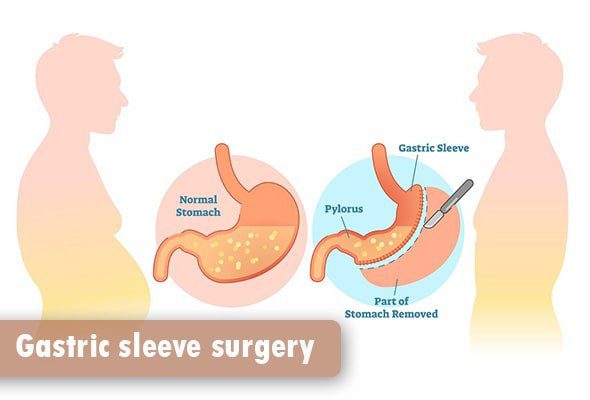Today, the obesity rate has reached its peak. In addition to affecting a person’s appearance and self-esteem, obesity is the cause of many serious and dangerous diseases such as type 2 diabetes, cardiovascular disease, stroke, and various cancers such as breast and colon cancers. The US Centers for Disease Control and Prevention says more than a third of adults in the United States are obese. With the increase in obesity in the world, the number of weight loss surgeries (bariatric surgeries) will naturally increase.
But is weight loss surgery dangerous?
Contrary to many people’s beliefs, the surgery is very safe and low-risk today. Also, bariatric surgeries, unlike in the past, which was much more challenging due to the use of open and invasive methods, are performed by laparoscopy, which is the newest method of surgery.
In this type of minimally invasive surgery, several small incisions are made in the abdomen, through which a laparoscope and other surgical instruments are inserted into the body, and surgery is performed. The recovery period after laparoscopic weight loss surgery is much shorter than open surgery. Here are some of the safest weight-loss surgeries.
Gastric sleeve surgery in Iran

Gastric sleeve surgery in Iran, which is one of the most widely used surgical procedures in the world today, involves the removal of about 80% of the stomach, which also includes the part that secretes the hunger hormone (ghrelin). The remaining stomach is sutured to form a long, narrow shape like a banana or a sleeve.
How to lose weight: As the volume of the stomach decreases and the hunger hormone suppresses, the patient receives much fewer calories, and his/her weight is significantly reduced.
Approximate weight loss: Most patients will lose about 30 to 50 percent of their excess weight in 6 to 12 months and 50 to 70 percent in 2 years after gastric sleeve surgery. Weight loss in this surgery is slower than gastric bypass, which reduces the risk of sagging skin after weight loss surgery.
Suture site: Laparoscopic incisions are about 1.5 cm each, and the suture site from the surgery heals quickly. So, the patient can return to the normal daily routine very soon after gastric sleeve surgery.
Gastric bypass surgery in Iran

Gastric bypass surgery in Iran is also one of the safest weight loss surgeries because it is performed laparoscopically. During this surgery, a part of the stomach is removed and the rest of the stomach is sutured. At the same time, a part of the small intestine is cut and attached to the new stomach. In fact, in this surgery, the passage of food through the intestine will change.
More Study : How liposuction is done?
How to lose weight: The patient feels full much faster than before after gastric bypass surgery in Iran. Also, due to the change in the passage of food through the intestine, fewer calories and nutrients are absorbed by the body.
Approximate weight loss: 65 to 80% of extra weight will be reduced in 18 months.
Suture site: Each laparoscopic incision is about 1.5 cm long and will improve over time and disappear. This surgery will be performed under general anesthesia.
Abdominoplasty in Iran

Abdominoplasty or Tummy Tuck is a procedure in which excess fat and skin of the abdomen are removed and the abdominal muscles are tightened.
The result of this surgery is not permanent and the patient must maintain a healthy lifestyle after surgery by following a healthy diet and having physical activity. Patients decide to have abdominoplasty for a variety of reasons, some of which may include weak abdominal muscles after pregnancy or heavy weight loss.
Although abdominoplasty is necessary for some patients, this surgery should not be considered as a treatment for obesity or the removal of visceral fat.
During abdominoplasty in Iran, the patient undergoes general anesthesia. Two incisions are made for surgery: one near the pubic area and the other around the navel. The skin will be separated from the abdominal muscle. The abdominal muscles are then pulled together and sutured to be tightened and the patient looks slimmer.
The detached part of the skin is then stretched over the muscles, which have now taken on a new shape, and the excess skin is removed. The navel is reconnected to a part that looks normal. The incisions are closed and a sterile dressing is applied to the surgical site. Abdominoplasty surgery takes 2 to 5 hours.
Lipomatic or liposuction in Iran

Liposuction (also known as lipomatic) is a minimally invasive surgery that is one of the safest surgeries for weight loss in Iran. Liposuction involves the selective removal of fat tissue from various parts of the body using small incisions. It creates a slim and fit appearance with the shortest recovery time.
Liposuction in Iran removes excess localized fat from various areas of the body, such as the thighs, buttocks, abdomen, waist, back, arms, knees, chin, cheeks, double-chin, and ankles. In this procedure, your surgeon will choose local or general anesthesia for your surgery, depending on your condition.
To perform liposuction, the surgeon makes a small, delicate incision near the target site. Initially, a sterile, diluted local anesthetic is injected to reduce bleeding and trauma. The surgeon then inserts a thin, hollow tube called a cannula through the incisions, and with reciprocating movements, removes excess fat from the body using the vacuum device.
Gastric band surgery in Iran

In this weight loss surgery, the surgeon inserts an adjustable silicone ring around the first part of the stomach, slightly below the junction of the esophagus and the stomach. A tank is also installed under the skin of the abdominal wall for further adjustments. By injecting sterile distilled water into this tank, the ring becomes narrower, thus limiting the amount of food entering. A patient who has undergone gastric band surgery may vomit if overeats.
In gastric band surgery in Iran, the length of the operation is shorter and the least manipulation is done in the gastrointestinal tract. So, it is definitely one of the safest surgeries for weight loss.
In contrast, since gastric band surgery has no effect on the hunger hormones that cause obesity and diabetes, the patient is always feeling hungry, so may turn to bad eating habits sometime after the operation. Therefore, weight loss in this bariatric surgery is less than other methods.
Related post
What to eat after tummy tuck and liposuction?



